You are using an out of date browser. It may not display this or other websites correctly.
You should upgrade or use an alternative browser.
You should upgrade or use an alternative browser.
2004 FG649-the journey so far
- Thread starter mab
- Start date
mab
Observer
The next issue was the instrument panel lighting. Very dull. A bit of internet research and I found LED replacements for the instrument panel bulbs. they were very cheap, less than $2 each on eBay. I had the instrument cluster out anyway with the full dash dismantle. The thing with the LEDs is that they are polarity conscious, which meant that I had to individually test each bulb once installed. Again the service CDs' were great. I was able to cross reference several diagrams and locate the harness plug connections for each bulb, connect my test 12 volt supply and confirm the operation of the LED. Some of the original bulbs that I removed were marked as 24 volts which would explain the lack of illumination.
Any unused bulb sockets on the back of the cluster were taped over, as well as any open holes into the back, so as to stop the light escaping. Most of the tape was peeling, so it was removed and the surfaces cleaned and retaped.
I also took the time to clean around each of the light sockets connections on the back of the cluster as well as bend out the wipers on the bulb holders to ensure good contact. The first LED I replace was working intermittently until I did this.
The result is significantly brighter. I am as yet to fully reassemble the dash to see what it looks like in situ, but I expect it will be a great improvement.
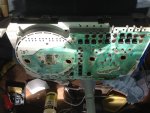
the back of the instrument cluster
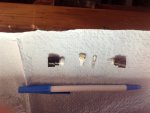
There are two size bulb in the instrument cluster, T5 and T10. Shown here are the T5's. From left to right we have the lampholder with a LED fitted, a LED, the standard bulb and the bulb in the lampholder. There were 15x T5 and 4x T10 bulbs in my dash
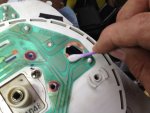
Cleaning around the sockets where the lampholders twist into place
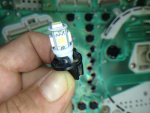
The T10 size LED in the lampholder. The four T10 lamps provide the general illumination for the instruments when the head lights are turned on.
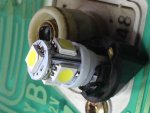
The T10 LED again. Note the wiper on the lampholder has been bent up for better contact.
Any unused bulb sockets on the back of the cluster were taped over, as well as any open holes into the back, so as to stop the light escaping. Most of the tape was peeling, so it was removed and the surfaces cleaned and retaped.
I also took the time to clean around each of the light sockets connections on the back of the cluster as well as bend out the wipers on the bulb holders to ensure good contact. The first LED I replace was working intermittently until I did this.
The result is significantly brighter. I am as yet to fully reassemble the dash to see what it looks like in situ, but I expect it will be a great improvement.

the back of the instrument cluster

There are two size bulb in the instrument cluster, T5 and T10. Shown here are the T5's. From left to right we have the lampholder with a LED fitted, a LED, the standard bulb and the bulb in the lampholder. There were 15x T5 and 4x T10 bulbs in my dash

Cleaning around the sockets where the lampholders twist into place

The T10 size LED in the lampholder. The four T10 lamps provide the general illumination for the instruments when the head lights are turned on.

The T10 LED again. Note the wiper on the lampholder has been bent up for better contact.
mab
Observer
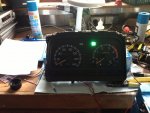
T5 lamp, indicator on.
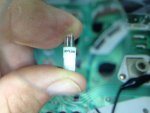
One of the old T5 bulbs removed. Clearly marked as 24 volts.

On the bench with the four T10 LED's on
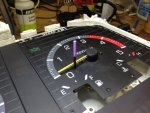
The clear front cover on the cluster was cracked and had been removed for replacement. During my repairs to the lights in the cluster I broke off the stop pin for the tacho needle. Very cranky at myself. Did a McGuiver and made a new pin out of the shaft of a cotton bud and coloured it in with black pen. Can't tell from a distance.
On the web it looks great and very well thought out. I thought I did my research for my delude on box but it has turned into an expensive nightmare. I could have almost paid for a wedgetail by now. I'd be keen to know your thoughts. Make sure the legs are stable when it is freestanding.
Looks like you are making great progress with your truck. I was up at ATW last week and had their ATB front diff installed. The guys there are great. John showed me a couple of the trucks and I now have serious truck envy.
I'm looking into getting my tray modified, mainly the headboard as cracks are appearing and looking at getting a trundle tray underneath as there is heaps of wasted space up there.
Looks like you are making great progress with your truck. I was up at ATW last week and had their ATB front diff installed. The guys there are great. John showed me a couple of the trucks and I now have serious truck envy.
I'm looking into getting my tray modified, mainly the headboard as cracks are appearing and looking at getting a trundle tray underneath as there is heaps of wasted space up there.
